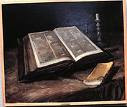
It can be observed that most of Marc Chagall's work is an expression of his philosophy, his religious sensibility if you will, in the form of the "literalization of metaphors", deeply grounded in the mystical and symbolic Hasidic world and Yiddish folktales, which include in their writings the "repository of flying animals and miraculous events."(Wilson, 2007)
It is impossible to label Chagall's work as "Expressionism", but the representation of an acute imagination, coloured in fantasy, depicting highly charged religious symbols, including in several works, Christs Crucifixion in a variety of contexts. What I love about Chagall is the viewer is drawn into the work by its striking colour and busy subject matter and is compelled to study it, because the meaning of the painting must be discovered as it is not apparent on a superficial viewing.
My favourite paintings by the artist are his various representations of love that display an ethereal, mystical quality, a sublimeness that to me captures love in their most revealing forms, as the author, Jonathan Wilson, writer of the latest biography of the artist states:
"Chagall's vision of love, so appealing to the human soul, frequently involves a merging of two faces, or bodies, into one. In this regard he is Platonic, as his figures pursue their other halves in an apparent longing to become whole again. Over and again he paints the myth that Aristophanes recounts in The Symposium." (ibid)
This notion is apparent in the painting depicted above; the merging of “two into one”.
Chagall's life, Wilson suggests, was an attempt through his art at the reconciliation between two worlds, a genuine effort at universalizing or merging opposites, he writes,
"In his paintings, past and present, dream and reality, rabbi and clown, secular and observant, revolutionary and Jew, Jesus and Elijah...all commingle and merge in a world where history and geography but also the laws of physics and nature have been suspended." (ibid)
Chagall was a man with an extraordinary imagination, an astonishing amount of energy and ambition, and considered by art historians as one of the true icons of Modernism along with Picasso and Matisse.
Source: Wilson, J.
Marc Chagall
Random House 2007
United States


No comments:
Post a Comment